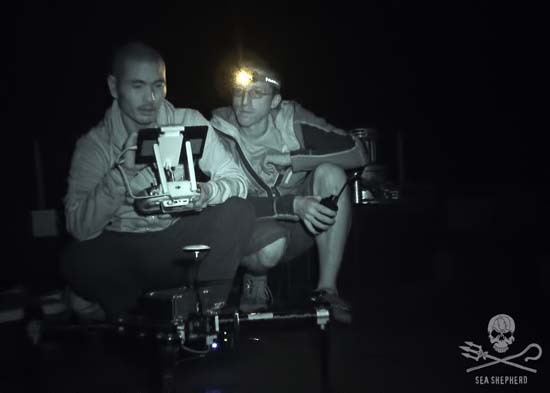Poachers working Mexico’s Sea of Cortez at night got a shock when they were buzzed by an environmental group’s quadcopter drone, equipped with a FLIR thermal night vision camera.
The video shows the poachers panicking, abandoning their illegal gillnet and fleeing at high speed in a panga.
The crew of the Farley Mowat, a Sea Shepherd vessel, continued to track the poachers via the drone while relaying the coordinates and headings to the Mexican Navy.
Death by Gillnet
After handing the chase over to the Mexican Navy, the Sea Shepherd vessel returned to the scene of the crime and recovered the gillnet, freeing four live cow-nosed rays and the bodies of two juvenile hammerhead sharks.
The poachers apparently escaped. Mexican authorities are notoriously inefficient – and often downright corrupt – when enforcing environmental and fishing regulations where big money is involved. And for these poachers big money was definitely involved.
They were after the rare totoaba fish, a native of the Gulf of Mexico which is capable of growing up to six feet long and living for 25 years. Chinese medicine prizes a tubular organ that regulates the fish’s buoyancy, thought to promote fertility in humans.
Killing the World’s Most Endangered Marine Mammal
As if poaching the rare totoaba wasn’t enough, illegal gillnets also kill many other species. Worst of all they threaten the vaquita—a shy, snub-nosed porpoise native only to the Gulf of California, and the most endangered marine mammal in the world. Only a few dozen individuals are believed to remain in the wild.
While all nets are dangerous to the vaquita, ones used to catch totoaba are especially so because of the mesh size. Vaquita entangled in the nets drown.
To save the vaquita, in April 2015 Mexico enacted a two-year ban on the use of gillnets in a large portion of the northern Gulf of California. But bans mean nothing to criminal poachers when huge amounts of money are at stake.
$137,000 for a Single Bladder
According to Greenpeace, totoaba bladders were selling at one point for as much as $137,000 in Chinese markets. Prices fluctuate, rising when effective law enforcement reduces supply. Prices are currently down. This fluctuation has encouraged some Chinese to buy the bladders as speculative investments, increasing demand and prices.
Asian cultures use totoaba swim bladders in a soup called fish maw. It is also believed to boost fertility, ease the discomfort of pregnancy, cure joint pain, and help other ailments.
On their way to China many bladders are being smuggled across the border into the United States. A single bust by U.S. Fish and Wildlife Agents produced 214 bladders hidden in one San Diego house, with an estimated value of $3.6 million.
Big Profits and Light Penalties
Despite the big money involved, only seven people have been prosecuted, receiving light fines and jail sentences.
Mexican officials, echoing their defense of drug trafficking in their country, blame the Chinese and say that country should take action to eliminate the market and demand. The Chinese, for their part, say they see little evidence of the illegal trade, claiming the bladders are hard to tell from other, legal fish bladders.
Meanwhile, the endangered totoaba and vaquitas continue a slide towards possible extinction.
Photo credit: Daniel Villa and Roy Sasano getting ready to launch predator. By Ognjen Milovic co: Sea Shepherd








